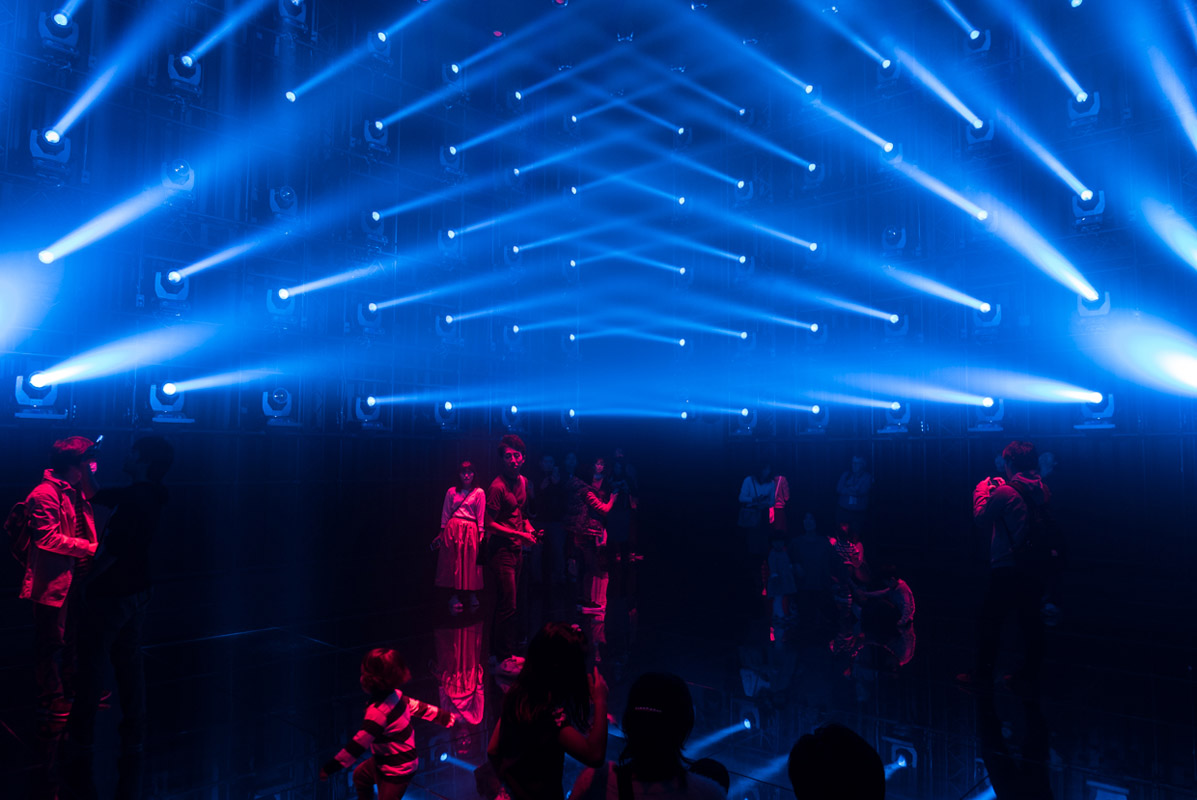Luca Zaffarano’s journey in Tokyo, at the Mori Building Digital Art Museum on Odaiba Island, continues. After describing the creative and business spirit at the heart of the interdisciplinary group teamLab (Part I), Zaffarano now guides us through the spaces they created – a total immersion in art, covering and subverting space, endowing it with intelligence and the ability to respond to visitors’ presence. Part I
(…) Let us try to describe in more detail what this consists of. The first space visitors come across is an explosion of moving flower patterns, presented through real time rendering, determined by visitors’ movements and, therefore, completely random. The floor and walls are covered in a soft material, while other walls are made of mirrors to increase the feeling of disorientation.
As people walk freely around teamLab Borderless they lose themselves in the artwork world. The borderless artworks transform according to the presence of people, and as we immerse and meld ourselves into this unified world, we explore a new relationship that transcends the boundaries between people, and between people and the world.” [teamLab]

All sections of this space, including the visitors themselves, are illuminated by projections representing fluttering butterflies, blossoms, petals that gently slide away, and change colours; the effect is enchanting and magical, even what is improbable seems possible, like in a Murakami novel. Flowers, petals and butterflies all symbolise that sense of fragility which permeates Buddhist cultural life, in which everything is ephemeral and nothing is immutable or eternal, just like the brief moment of beautiful blossoms. “Everything exists in a long, fragile yet miraculous continuity of life. This is teamLab’s universal concept throughout our creation.” [teamLab]

After an initial moment of wonder and uncertainty, it is clear that this maze-like structure cannot be easily understood and visitors must proceed by trial and error, discovering new rooms. Black Waves is the first room we step into. Abstract waves, similar to the night vision of a rough sea, are projected onto circular walls. In the middle of the room several mattresses can be found where visitors can lie down on. The soundtrack created by sound engineer Hideaki Takahashi (also available on Spotify) is probably one of the most beautiful ones to listen to. The composer mixes sound bands made of almost white noise to a minimal piano score, reminiscent of “ambient” music. The final white foam of the waves projected onto the walls, perfectly accompanied by the music, has a calming effect and allows us to reflect on how much beauty there is in the everyday randomness of nature.

In the next room, a series of installations with titles like Grid spaces, Light Vortex, Barrier, Descent of the Gods take shape inside a cube whose floor consists of mirrors and has four walls covered with fifty projectors that, together, form a grid of 200 projectors of luminous different-coloured stripes. These are all set in real time through a computerised sound and visual score that produces abstract shapes through grids, dances, flows and vortexes of light. If, on the one hand, the show is perhaps a little too “pop” to be truly innovative, on the other, it allows us to reflect on the compositional potential that was unavailable to so many avant-garde figures who imagined the dematerialisation of painting ahead of their time, starting from László Moholy Nagy. This artist theorised an art capable of painting the clouds in the sky with light. “I’ve always wanted to do just this to project light and color on clouds or on curtains of falling water. People would respond to it with a new excitement which is not aroused by two-dimensional paintings.” [László Moholy Nagy, in Sibyl Moholy-Nagy, Moholy-Nagy. Experiment in Totality, Longanesi, Milano, 1975, p. 73]


One of the spaces that has the most impact on visitors is Wander through The Crystal World, a path in a forest made of narrow stripes of led light, falling vertically from above. This unreal landscape, consisting of thousands of luminous dots and taking on tones that are both pleasing and scintillating, is reminiscent of heavy rain inside an infinite star-filled space.
… to be continued…

teamLab. Borderless, MORI Building DIGITAL ART MUSEUM: teamLab Borderless, 2018, Odaiba, Tokyo
images (cover 1) teamLab – Exhibition view of MORI Building DIGITAL ART MUSEUM: teamLab Borderless, 2018, Odaiba, photo: Parimbelli (2) teamLab – Exhibition view of MORI Building DIGITAL ART MUSEUM: teamLab Borderless, 2018, Odaiba, photo: Silvia Zaffarano (3) teamLab – Exhibition view of MORI Building DIGITAL ART MUSEUM: teamLab Borderless, 2018, Odaiba, Tokyo © teamLab. TeamLab is represented by Pace Gallery (4-5-6) teamLab – Exhibition view of MORI Building DIGITAL ART MUSEUM: teamLab Borderless, 2018, Odaiba, photo: Parimbelli (7) teamLab – Exhibition view of MORI Building DIGITAL ART MUSEUM: teamLab Borderless, 2018, Odaiba, Tokyo © teamLab. TeamLab is represented by Pace Gallery









































